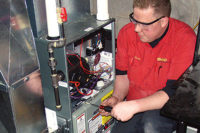When it comes to selling variable refrigerant flow (VRF) technology, one of the first things contractors need to do is determine when and where the technology should be applied.
“Almost any building can utilize VRF,” said Jeff Ledsinger, VRF product manager and director of sales in Houston, Bartos Industries. “There are some applications where it probably isn’t practical. Any building with multiple zones would be a good candidate for VRF.”
After determining VRF is the best fit for a project, the key is to talk about efficiency up front. “It’s perhaps the most efficient air-cooled system. You also want to talk about ease of installation, a reduction in install time, and labor savings. We typically start the conversation with a discussion on how efficient these systems are and how much money they can save over the course of time on electric bills.”
However, sometimes clients don’t leave contractors much of a choice when it comes to determining when to use certain equipment. “If the client is already convinced to go down the route of VRF or chillers, for example, we wouldn’t necessarily try to dissuade him from one course or the other unless we were clear the option he has chosen was not the right one for his building,” said Colin Mercer, director, Mercer Maurice Group, Reading, Berkshire, U.K.. “We were involved in a project earlier this year where the client was persuaded to use chillers. We were invited to tender for the project, but it very quickly became clear that chillers were not the way to go and that VRF would be a much better solution. The building was a high-rise, multi-tenant development with varying levels of usage throughout the day. In short, chillers were considered entirely unsuitable, and we persuaded the client to not only move over to VRF, but also to revise the distribution of the air conditioning systems throughout his building in order to get the best out of them.”
Jim Crist, a Baltimore-area independent HVACR contractor and board member of the State Board of Maryland HVACR Contractors, believes it’s the contractors job to educate consumers about the product and communicate the differences and benefits involved in order for them to fully understand what they are purchasing.
“Customers rely on you to steer them in the right direction. As with any other profession, chances are great the consumer doesn’t know anything about the product or new technology unless you bring it up,” he said. “We’ve been to sales calls that didn’t involve a VRF system, but, after we talked for a bit, that’s the product we sold them. Most are not familiar with the technology, although it is becoming more popular. If you have the patience and take the time to explain what the technology has to offer, it makes the sell much, much easier. Foremost, as a salesman, you must keep the old theory in mind that people buy from people they like. Many times, personality comes into play over technical knowledge.”
Communicating Benefits
From the consumer’s point of view, perhaps the most important benefit of VRF is its energy-efficiency savings potential. However, there are numerous advantages of which consumers may not be aware.
“To start with, a VRF system does not put all the eggs in the same basket in the way a central chiller can,” Mercer said. “Areas can be zoned; system distribution can be vertical through the building or horizontal, depending upon its orientation and usage; and the EER of properly designed and operated VRF systems are invariably better than a chiller system of the same capacity — particularly as far as low load performance is concerned. Plus, there is the ease of installation. There is little to go wrong as there are no pumps, dry air coolers/cooling towers, air-handling units, etc., and, in the event of a unit failing, it can be taken out of circuit while repairs are carried out and the rest of the system can continue to function. If a large chiller fails, then the entire system, or a large part of it, is usually out of action.”
Crist focuses on three major advantages, including energy efficiency, when selling VRF to clients.
“Between the high SEER energy ratings and the possibility to spot-cool by turning off several areas when they’re not occupied, the monthly operation cost savings speak for themselves. Secondly, if it’s a high-occupancy area, what better application can address different peoples’ comfort levels than VRF? One room could be 68?F, while another space may be 75?, and, if we introduce heat recovery, we can offer simultaneous heating and cooling applications with certain brands.”
VRF eliminates the need to employ separate controls contractors in commercial applications, said Ledsinger. “VRF is the closest to plug-and-play as possible,” he said. “With other commercial HVAC systems, you usually have to hire a separate controls contractor or separate controls provider, someone separate from the equipment provider. With VRF, the controls come with the equipment and, as long as you wire it in right, it all works, and you don’t need a separate controls contractor or provider. We use that one [selling point] a lot. The larger the job, the more money you save.”
Addressing Cost Concerns
VRF applications typically feature high initial costs, which may cause some clients to hesitate when considering the purchase.
“Installation cost and time plus the efficiency, as described above, can easily overcome the higher initial cost. Plus, lower maintenance bills will be coming in the future,” Mercer said.
The best solution to overcoming cost concerns is for contractors to learn how to properly estimate a job.
“In the past, before contractors were familiar with VRF, they would add a lot of fudge factor into their pricing because they didn’t know quite how to do it,” Ledsinger said. “Now that they’re familiar with it, we have contractors that can price it accordingly, and it’s very competitive with other commercial HVAC technologies. Usually, on an overall HVAC contract basis, VRF projects come in very competitively priced.
“When VRF is compared to other technologies on an equipment basis, just equipment versus equipment, it’s usually going to come in higher because there are more components and they are a little bit more advanced electronically,” Ledsinger continued. “But, then you start factoring in labor savings, the savings on controls, and other savings. If you just look at equipment versus equipment, they may go into sticker shock, but the contract itself to put HVAC
in the building might be less for VRF. You must also take into account architectural savings because VRF takes up less space, structural savings because VRF weighs less on the roof than most of its counterparts, and electrical installation savings because VRF indoor components don’t draw very much energy, so your panels can be smaller, disconnects and fuses are all smaller, and the wiring is smaller. All of that adds up to a lower upfront cost than most competitive technologies. Looking down the road, past initial costs, the energy savings are substantial.”
Publication date: 11/24/2014
Want more HVAC industry news and information? Join The NEWS on Facebook, Twitter, and LinkedIn today!








